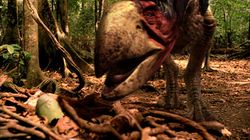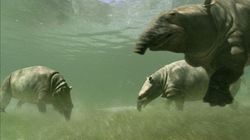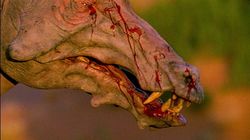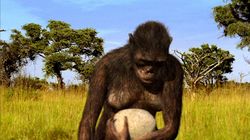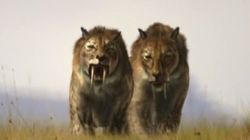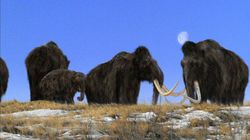Walking with BeastsŐsállatok között

Angol címe: Walking with Prehistoric Beasts
8.3 IMDbWalking with Beasts is a 2001 documentary series, produced by the BBC in the United Kingdom, narrated by Kenneth Branagh.
Befejezett / kaszált 2001.11 - 2001.12 | 60 perc @BBC One , GB
Alkotó: Tim Haines
Galéria
Kenneth Branagh (Narrator),
Stockard Channing (Narrator)
Honlap | IMDb | SorozatJunkie | TV Maze | TMDB
11.15.
22:00
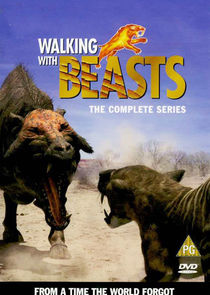
Epizód adatlap | SorozatJunkie | IMDb | Hozzászólások (0) |
49 million years ago, Early Eocene (Germany) Filming location: Java
The first episode depicts the warm tropical world of the early Eocene which was 16 million years after the extinction of the non-avian dinosaurs. Birds, including the giant carnivorous Gastornis, rule this world, while mammals are still very small. The setting is near the Messel pit in Germany. Due to volcanic activity, sudden bulk escapes of carbon dioxide trapped underneath lakes pose a significant hazard to the local wildlife. The episode centers around a Leptictidium family, a leaping, shrew-like mammal, which has emerged in the dawn hours to forage for food. As the mother Leptictidium forages, first in solidarity, and then with her pups, she wanders near a large predatory mammal, identified as an Ambulocetus ("walking whale"). Despite its crocodilian similarity, the Ambulocetus is shown swimming by caudal undulation like a modern cetacean. A female Gastornis, who has been taking care of the single egg in her nest, makes two attempts to hunt a small herd of Propalaeotherium. The first attempt fails when sounds among the vegetation betray her presence. The second attack proves successful when the Propalaeotherium consume fermenting grapes and are unable to evade her attack. The Gastornis also defends her territory from another Gastornis. Unfortunately, while the mother hunts, a horde of Formicium (identified as giant carnivorous ants, and the identified species later renamed to Titanomyrma) encounter the egg when it was just starting to hatch. When the female discovers her dead offspring at dusk she leaves the forest to try and start another family.
With the arrival of night, a band of lemur-like Godinotia, socialize and copulate in the dark. Ambulocetus finally manages to catch a small carnivore near the lake edge. As the night wears on, an earth tremor unleashes trapped carbon dioxide out from underneath the lake and the gas suffocates most of the surrounding life. The Leptictidium survive because the nest was upwind of the gas, and Gastornis also survived because she left that area in the forest.
It is mentioned that although the Leptictidium survived the gas, they would ultimately leave a mystery if that species had a descendant like a shrew or not but most likely they left no descendants, while the Ambulocetus (who was killed by the lethal gases) would evolve into the whales, hereby setting the scene for the next episode.
Animals: Leptictidium · Gastornis · Ambulocetus · Propalaeotherium · Godinotia · Eurotamandua · Titanomyrma · Creodont · Gecko · Crocodilian (live-acted by a mugger crocodile) · Frog (live-acted by a White's tree frog) · Snake (live-acted by a red-tailed green rat snake) · Bats (in book only)
11.22.
22:00

Epizód adatlap | SorozatJunkie | IMDb | Hozzászólások (0) |
36 million years ago, Late Eocene (Pakistan/Tethys Sea) Filming location: Florida
The second episode is set in late Eocene, when the polar caps froze over and drastically changed the Earth's ocean currents and climate. The first part of the episode explains how an early whale, Basilosaurus mates and how the world is changing into an ocean famine. On land there is an Andrewsarchus driven to the beach to feed on sea turtles. The narrator explains that Andrewsarchus, the largest land mammal predator ever to walk the earth, has hooves and is related to sheep, so it is, in a sense, a "sheep in wolf's clothing". Back in the ocean, a starving mother Basilosaurus is forced to hunt in the mangrove swamps of Africa, which will later become the Sahara Desert. Unable to catch a primate called Apidium due to a shark killing one of the primates and spooking the others, she is then hunting a lone Moeritherium. The Moeritherium crawls on to land, but in the mangroves, land does not last long. However the Moeritherium escapes and the Basilosaurus returns to the sea. The cast moves on to land where a herd of Embolotherium (identified as Brontothere) struggle to survive : one of their calves dies after birth and two Andrewsarchus feast on it but the mother Embolotherium drives them away because she has a strong bond with her offspring, even if it is dead. Back in the sea the mother Basilosaurus preys on a group of Dorudon and is successful. The episode ends with the mother Basilosaurus swimming with her newborn calf.
Animals: Basilosaurus · Andrewsarchus · Embolotherium (identified as Brontothere) · Dorudon · Moeritherium · Apidium · Physogaleus (identified as a shark) · Puppigerus (identified as a turtle)
11.29.
22:00

Epizód adatlap | SorozatJunkie | IMDb | Hozzászólások (0) |
25 million years ago, Late Oligocene (Mongolia) Filming location: Mexico, Arizona
The third episode takes place during the late Oligocene, in Mongolia, where there were seasonal rains followed by a long drought. It tells the story of a mother Paraceratherium (identified as Indricothere), a massive hornless rhinoceros that was the largest land mammal to have ever lived. The episode first shows the mother Paraceratherium giving birth, and then tending to the male calf as it matures. A few minutes after giving birth, the mother defends the helpless calf from several Hyaenodon. Also, the mother's old calf tries to come back, but is chased away. It gives a snapshot into the future of the calf. The mother raises her calf for three years, but eventually chases him away after she mates with another male. The episode then chronicles the young Paraceratherium travels until it reaches adulthood, including encounters with the Cynodictis (identified as bear dog), and the large aggressive Entelodon.
Animals: Paraceratherium (identified as Indricothere) · Hyaenodon · Entelodon (identified as Entelodont) · Chalicotherium (identified as Chalicothere) · Bear dog (Cynodictis)
12.06.
22:00

Epizód adatlap | SorozatJunkie | IMDb | Hozzászólások (0) |
3.2 million years ago, Late Pliocene (Ethiopia) Filming location: South Africa, Ethiopia
The fourth episode takes place in the Great Rift Valley in northeastern Africa of the late Pliocene. The climate has changed, and now great grasslands have replaced trees. The episode focuses around a tribe of small hominids known as Australopithecus, one of the first apes able to walk upright and a close ancestor to humans. The Australopithecus has evolved to walk upright so as to better maneuver the plains as well as the climb the trees. However, it notes that although the Australopithecus looks human, it still only has the mind the size of a chimpanzee's. Some of the topics explored in the episode are the close social bonds among the tribe, how they use grooming as a means of communication, and how they work together to forage for food and to defend one another from attacks from such animals as an angry male Deinotherium, an ancestor of the modern elephant which they have to run from to avoid being crushed, and the feline predator Dinofelis. It touches upon how competing tribes of Australopithecus war among one another, although most of fighting is for show. It also explains the hierarchy in the tribe among the males (who are much larger than the females) and tells a story of how the dominating male is eventually overcome by another male, who wins the right to feed first at a carrion and to mate with the females. The main story tells of a young Australopithecus nicknamed Blue whose mother has been killed by malaria. He and his tribe are later forced to flee their homeland during a fight over a waterhole with a rival tribe. After a long journey in search of a new home, Blue fits into his tribe by causing them to scare off a hungry Dinofelis.
Animals: Australopithecus · Dinofelis · Deinotherium · Ancylotherium · Warthog · Rhinoceros · Jackal · Vulture · Zebra (carcass) · Ostrich
12.13.
22:00

Epizód adatlap | SorozatJunkie | IMDb | Hozzászólások (0) |
1 million years ago, Early Pleistocene (Paraguay) Filming location: Brazil
The fifth episode shows the strange fauna of the isolated continent of South America and explores the effects of the Great American Interchange, which had happened 1.5 million years earlier. Since South America had drifted apart from Antarctica 30 million years ago, many unique mammals had evolved, including the Doedicurus, an armored armadillo-like mammal with a cannon ball-sized spiked club on its tail; the Macrauchenia, a camel-like mammal with a long trunk; and the Megatherium, a giant ground sloth. Before the continents of South America and North America collided, a 10-foot-tall predatory terror bird called Phorusrhacos, had reigned as top predator. However, the great cats migrating from the north, soon displaced them as top predators. The episode focuses on a male Smilodon, a sabre-toothed cat, called Half Tooth, whose leadership of a pride is threatened by two males who are brothers and work together against him. The rival males ultimately chase off Half Tooth (actually Half Tooth backs off wisely without any serious injuries, feeling that the two males would be too strong for him), kill his cubs, and take over his pride. Next, the episode shows the Smilodon cats hunting down Macrauchenia and trying to protect the young from the two brothers (in vain). In the background, "terror birds" still hunt, but give way to the Smilodon. However, a Megatherium, who wanted to eat meat as diet supplement, charges the pride of Smilodon, in order to eat some of the carrion. In the process, the Megatherium kills the dominant rival male, enabling Half Tooth to return, kill the other male and reclaim his territory. A year later, his mate had another litter of cubs.
Animals: Smilodon · Phorusrhacos · Macrauchenia · Megatherium · Doedicurus
12.20.
22:00

Epizód adatlap | SorozatJunkie | IMDb | Hozzászólások (0) |
30,000 years ago, Late Pleistocene (Belgium) Filming location: Yukon
The sixth episode takes place during the last Ice Age of the late Pleistocene. It starts in the peak of the summer. The North Sea has become a grassy plain because the ice at the polar caps has caused the sea levels to drop significantly. Grazing on the plain are herds of woolly mammoths, saiga antelopes, and bison. A clan of Cro-Magnons (identified as humans) is also there spending the summer. The central focus of the episode is the migration of the herd of mammoths as they travel 400 kilometers from the North Sea to the Swiss Alps for the winter and then back again in the spring. As the mammoth herd migrates south, the episode shows two large deer, the Megaloceros, fighting for rights to a harem of females. As the male Megaloceros fight, a group of humans ambushes them and kills one. A mother mammoth and her baby are separated from the herd, but survive an encounter with a cave lion. When the herd of mammoths reaches the Swiss Alps, the mother and baby mammoth reunite with their herd. The episode also depicts a clan of Neanderthals, who have especially evolved to survive in the cold climate. One is charged by a woolly rhinoceros, but escapes, in part because of his stocky constitution. The climax of the episode is when the clan of Neanderthals attack the herd of mammoth as they turn back to the north. The Neanderthals are gifted hunters who are able to chase two mammoths off a cliff by using fire and spears, one of them being the matriarch of the herd. The episode ends in the Oxford University Museum of Natural History with people looking at various skeletons of some descendants of the animals featured in the series. The camera then pulls back through the roof of the museum until the whole world is visible. The narrator states that, "We have since built museums to celebrate the past, and spent decades studying prehistoric lives. And if all this has taught us anything, it is this: no species lasts forever."
Animals: Woolly mammoth · Megaloceros · Woolly rhinoceros · Cro-Magnon · Cave lion · Neanderthal · Saiga antelope · Grey wolf · Wisent
